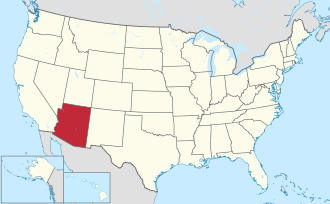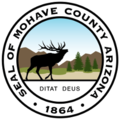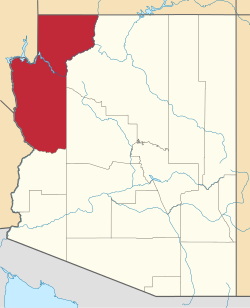Mohave County | |
|---|---|
 Mohave County Courthouse in Kingman | |
 Location within the U.S. state of Arizona | |
 Arizona's location within the U.S. | |
| Coordinates: 35°40′55″N113°51′47″W / 35.6819°N 113.8631°W | |
| Country | |
| State | |
| Founded | November 9, 1864 |
| Named after | Fort Mohave |
| Seat | Kingman |
| Largest city | Lake Havasu City |
| Area | |
• Total | 13,461 sq mi (34,860 km2) |
| • Land | 13,311 sq mi (34,480 km2) |
| • Water | 150 sq mi (400 km2) 1.1% |
| Population (2020) | |
• Total | 213,267 |
• Estimate (2024) | 226,479 |
| • Density | 16/sq mi (6.1/km2) |
| Time zone | UTC−7 (Mountain) |
| Congressional districts | 2nd, 9th |
| Website | www |
Mohave County occupies the northwestern corner of the U.S. state of Arizona, one of 15 counties in the state. As of the 2020 census, its population was 213,267. [1] The county seat is Kingman, [2] and the largest city is Lake Havasu City. It is the fifth largest county in the United States (by area).
Contents
- History
- Geography
- Adjacent counties
- National protected areas
- Demographics
- 2020 census
- 2010 census
- 2000 census
- Politics, government, and infrastructure
- Education
- K-12 school districts
- Colleges
- Public libraries
- Transportation
- Major highways
- Airports
- Communities
- Cities
- Town
- Census-designated places
- Ghost towns
- Indian communities
- County population ranking
- Economy
- Mining
- See also
- References
- External links
Mohave County makes up the Lake Havasu City–Kingman, Arizona Metropolitan Statistical Area.
Mohave County contains parts of Grand Canyon National Park and Lake Mead National Recreation Area and all of the Grand Canyon–Parashant National Monument. The Kaibab, Fort Mojave and Hualapai Indian Reservations also lie within the county.


